Checking the oil level in the engine - simple formality?
A simple and insignificant at first glance, the procedure for checking the oil level in the engine is actually more than formality. This procedure will help not only pay attention to the possible breakdown of the engine and prevent it. Regular level check can give a spelling driver a lot of useful information about the state of the car and plan the necessary work. Below you will learn about all the features of oil level control, reasons and consequences of increasing or lowering its level, as well as how to proper oil into the engine of your Iron horse.
How many oil should be in the engine
Let's start with the simplest question, how much oil on the standards can be in the engine? Moved the driver's experience knows that any liquid or lubricant in the car should be moderately. If you pour or, on the contrary, it is better not to dismiss something at your discretion, it will be better not, everything should be flooded exactly as indicated in the manual for the specific car. Especially if the conversation goes about the engine - the "heart" of any car. So, if in the manual it is indicated that the volume of oil in the engine should be 3.75 liters, which means that it is necessary to fill it with small nuances, which we will tell a little lower.
Before proceeding with technical details, let's determine in what cases the oil level is needed?
- Through a certain number of kilometers traveled. Typically, the manufacturer gives its recommendations for each specific auto model, but it will be good if the driver will check the level at least once every 1-2 thousand km.
- Through a certain amount of time. For example, once a week, even if the car worked a little and the mileage is completely small. There may be oil leaks through the glands, gaskets, hose joints.
- Before long trips.
- Before the start of operation of the car after the acquisition of "with hands" or after a long downtime.
- If you even have the slightest doubts in the correct operation of the engine: new sounds appeared (whistling, something tapping), there was a strange smell in exhaust gases or they changed the color, changed the thrust of the engine, there are problems with oil pressure, other symptoms appeared.
- With a sudden change in the level of coolant.
- Well, of course, it is necessary to carry out control measurements, if after the parking lot you drove a couple of meters and saw that a characteristic oil puddle was formed under the car or just a few drops of oil.
It should also be considered that the more car mileage and more of its age, the more often this indicator is required.
Check with your own hands: how to measure the dipstick
So, we decided how much oil in the engine should be and in what cases it must be checked. Now let's talk about the peculiarities of an independent level check. Before the process, you need to warm up the engine and put the car on a flat horizontal surface for a more correct measurement. Move the engine, wait 5-10 minutes - during this time the oil stalks into the engine crankcase. Then remove the measuring probe from the engine (usually it is located next to the engine cylinder block, the location for a particular car must be clarified in the manual before working), carefully wipe it with a clean cloth from oil residues and re-enter until it stops into the engine opening. After a couple of seconds, you can pull it out and visually determine the oil level. It should be higher than MIN risks, but below the MAX risks (these risks are not always signed, mean the minimum and maximum allowable oil level), preferably - closer to the middle.
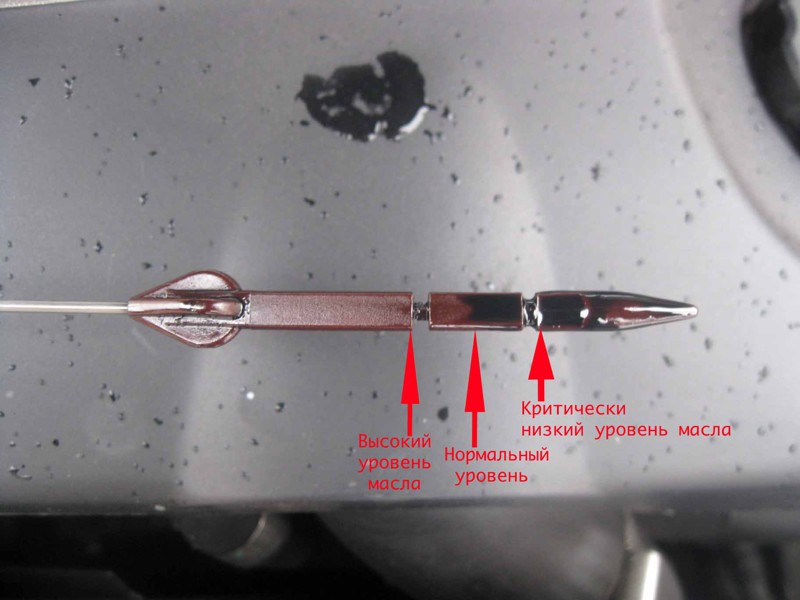
In this photo, it is shown how the probe will look at the normal oil level
Attention! Do not check the oil level on the engineered engine. First, it is unsafe, secondly, so you will not get the correct result, because after stopping the engine you need to give an oil time to drain from the cylinder walls into the engine crankcase, only after that you can proceed to measurements. It is also not worth checking the level on a completely cold engine, especially with a negative temperature on the street, it can also give an incorrect result,.
Similarly, you can check the oil level on any engine, whether it is gasoline or diesel, opposite or V-shaped.
How to check: video about frozen on Subaru
Oil level sensor
Above, we talked about the control of the oil level using the probe. However, the driver has one more way to follow him. It does not cancel the need to regularly check the level visually using the measuring probe, but complements it. In addition, he is always before his eyes. This is an electrical oil level sensor. It allows the driver during the movement of the car to control the level of oil in real time along the signals. The sensor indicator is displayed on the instrument panel of the control and when the oil level lack immediately notifies the driver. It is necessary to constantly pay attention to the incucation of this device, and if it triggers, stop moving, drown out the engine and check the oil level using the probe.
The principle of operation of the sensor is extremely simple: the mechanism looks like a gercon with the contacts open in normal state (when they are completely in engine oil). In this case, the oil indicator does not burn. But if suddenly the oil level fell, then the sensor contacts are closed and the indicator light lights up on the instrument panel.
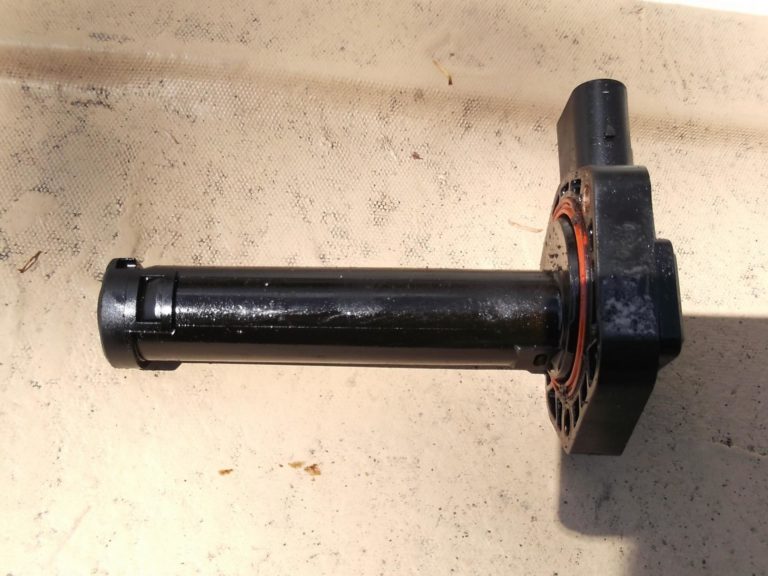
So the sensor looks like for some BMW models
However, like any electric car detail, sooner or later, the oil level sensor fails. Therefore, if it suddenly lights up the icon on the dashboard or, on the contrary, it stops burning, it is recommended to check and replace the electronic sensor if necessary (especially when the probe shows the normal oil level). Especially since this is a simple procedure that does not require special skills or tools.
- Disconnect the feed wire from the sensor.
- Unscrew the sensor using the key of the desired size.
- We pay attention to the sensor to be removed along with the sealing ring, it is also subject to replacement.
- Gently screw the new sensor with a new sealing ring, observing the tightening torque, so as not to thread the thread when installing.
- We connect the wire in place, checking the contacts if necessary.
If the indicator is above the maximum
How to be if the check showed that the oil level is above the maximum? If the level is exceeded slightly, then the only reason is overflowing the oil when it is replaced (for example, 4 liters were infused instead of 3.75 by instructions). In this case, it is not necessary to worry, but should not begin to exploit a car with an overly high level of oil, otherwise the excess fluid can begin to be squeezed out from the glands and gaskets, which will inevitably lead them to failure and requires replacement, that is, the service life to decrease artificial through . Also, an excess of oil will fall into the crankcase ventilation system and in the cylinders, and the excess of lubricant in exhaust gases over time inevitably rules the road catalytic conversion.
Therefore, if the oil level is exceeded, do not be labeled and drain the excess via the engine drain plug or remove it using a syringe through the screw hole, pre-attaching a flexible tube to it (for example, from a dropper).
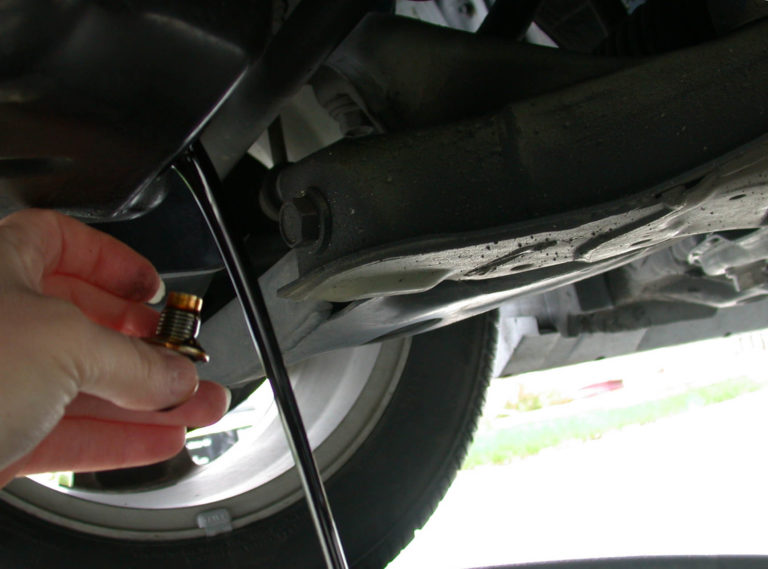
With a large overflow, unscrew the cork and pour over the drain hole
Double oil level
Much worse if the check showed the dual (1.5 and higher) oil level. This means that in front of you on the dipstick is not clean oil, but a mixture of coolant oil (coolant: antifreeze or toosol) or fuel - more to increase it nowhere. This happens for various reasons:
- Damage (exercise) laying the head of the cylinder block (GBC), why and the eating coolant occurs. Rurating pads are more often found on worn engines; engines that were operated "at the limit"; when the engine overheating; when using poor-quality coarse, which turns into ice in winter; When the driver adds cold coolant to hot.
- Cracks or microcracks directly with CHC, as a result of mixing coolant and lubrication can be easily. Causes are similar.
- Damage to the fuel pump diaphragm, as a result, getting fuel into the oil. Reasons - the use of poor-quality fuel, which is destructive effect on the aperture of the fuel pump; wear of the gas station.
- Incorrect settings of the carburetor (too high gasoline level in the float chamber) or breakage of the injector nozzles (not closed hermetically), the result is known - fuel from the oil. Regular checking and adjusting the carburetor, including the fuel level in the float chamber. In the case of an injection engine - regular check, cleaning and if necessary, replace nozzles.
If you have noticed a suddenly rose oil level, the car is categorically forbidden to exploit! It is already necessary for him to repair quite expensive, but if you continue exploitation, the maximum through 100-200 kilometers the engine can "swamp". This will happen because the oil will no longer perform its basic functions, goes will begin to appear on the walls of the cylinders, and this will soon lead to the encoding of the pistons. In this case, it will not be avoided overhaul or, in the worst case, the replacement of the engine.
Often hitting the coolant to the oil can be identified visually:
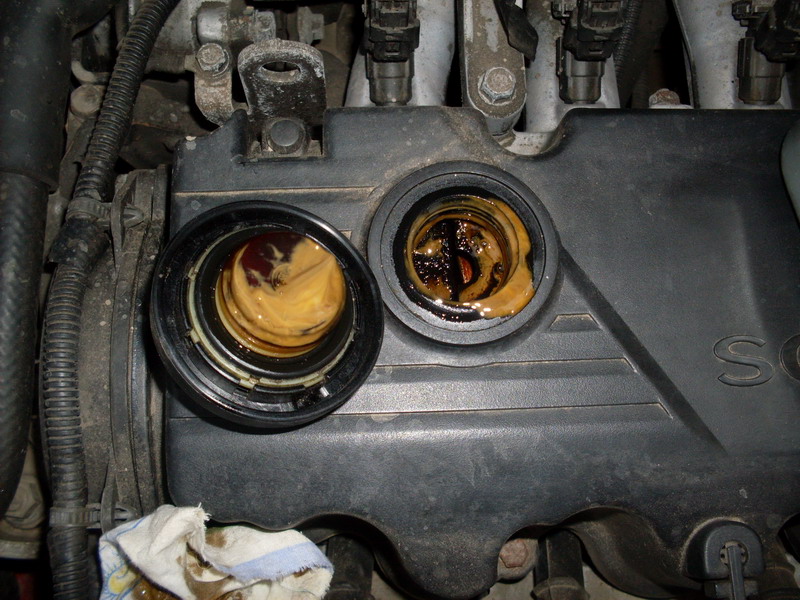
When coolant in the oil, its color and consistency is changing
The best thing you can do in this case is to deliver a car into a proven service for repair, as independent repair in such cases is complicated or impossible without specialized tools, equipment and knowledge. It will be necessary to replace the gasket GBC, possibly grinding and welding or replacing the GBC itself. At best - repair or replacement of carburetor / nozzles. In any case, after repair, it will be necessary to completely replace the oil and oil filter.
Low or no lubrication
There are two main reasons for low oil levels: avgar and disruption of oil system tightness.
In general, the avgar is a completely natural process and at certain limits it will be admissible. Oil film, lubricating the walls of the cylinder, heats up and burns out. For modern engines, the oil is permissible, the oil is considered if it ranges from 0.1% to 0.3% of the fuel consumption for gasoline engines and is raised from 0.8% to 3% for diesel. For example, if your gasoline engine "eats" 10 liters of gasoline by 100 kilometers, then it will be allowed to avail an oil of 30 ml oil per 100 km or 300 ml per 1000 km. Naturally, this average digits, much depends on the volume of the engine (for V6 or V8 engines, the avgar will be greater), designs (some models of the engines burn quite a lot of oil and the manufacturer considers it absolutely normal), operating conditions and travel manners (permanent ride on increased revs Increases the avgar of oil), the age of the engine (with the time of the inchar, the oil will increase).
So if the pointer is lowered not too rapidly (as a rule, the distance between risks on the probe corresponds to about one liter of oil), then you should not worry enough, it is enough to easily add similar oil into the engine to the required level (synthetics, semi-synthetics or mineral water depending on Manufacturer's instructions).
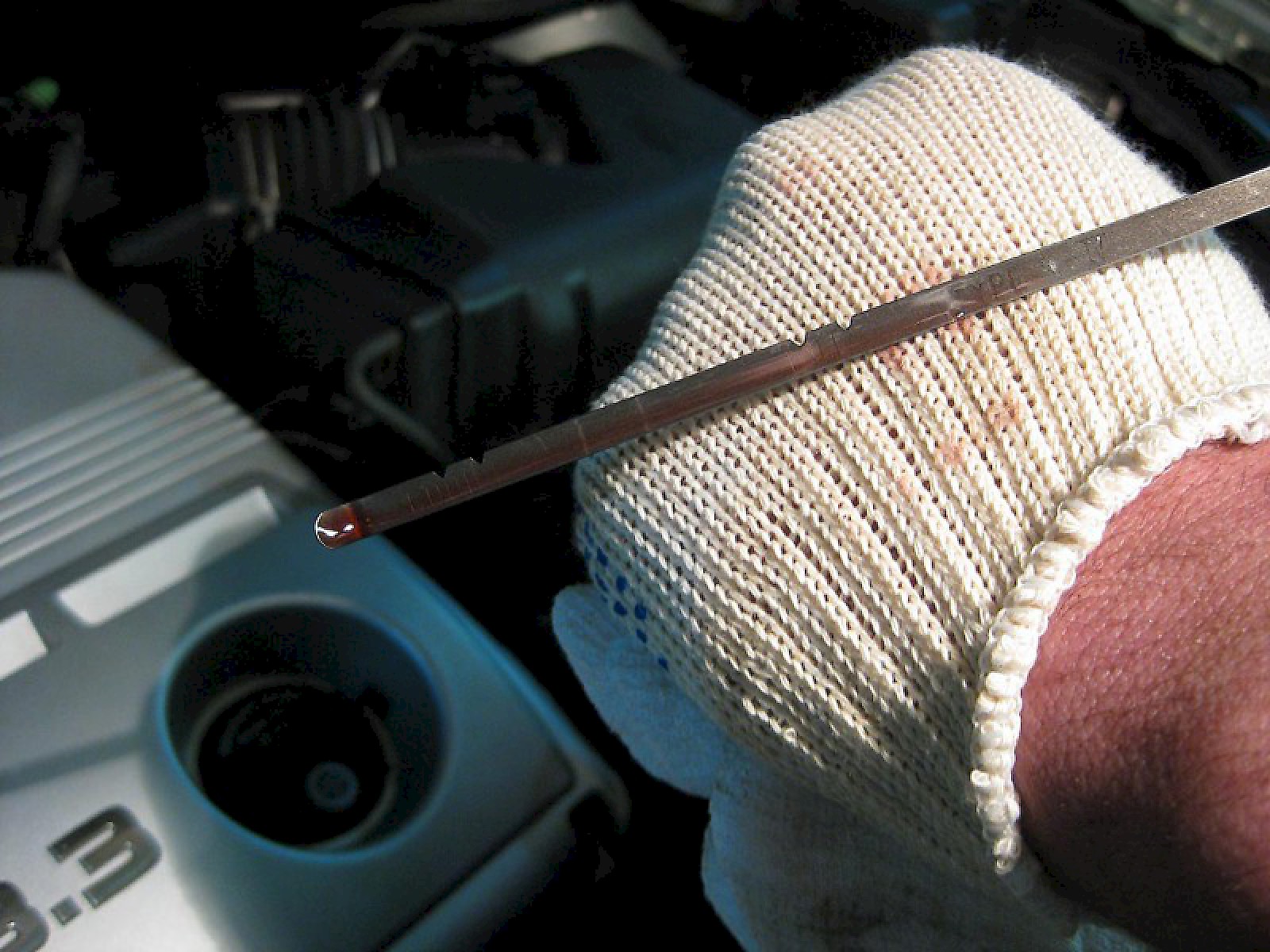
The older the car, the more likely it will eat oil
If there is already a passing of oil exceeds reasonable limits, you should think about the repair of the engine with a preliminary diagnostics (see table).
The second cause of low oil level is a disruption of the tightness of the oil system, in other words - leak oil. It is necessary to periodically inspect the engine from all sides to notice the oil flow. Usually the oil begins to flow through gaskets, glands, hose joints. Naturally, it is easier to act on a clean engine, so keeping the engine clean - not just fault. However, not any flow can be seen without placing a car to a hole or even without a special tool. Therefore, with suspected disruption of the tightness of the oil system (for example, drops of oil on asphalt under the car after parking) it is better to turn to a professional master.
We give a table that allows the driver to roughly understand the reason for a sharp decrease in the oil level, but the final decision on the need and the form of repair should receive a professional.
Table: Causes of problems and options for eliminating
| Reason for reducing level | Possible way to eliminate |
| Flow through the seals of the crankshaft and distribution shafts | Replace the seals to new |
| Flow through the gasket GBC | Perform checking the plane of the adjacent head and the cylinder block. If necessary, perform grinding head or block. In any case, replace the gasket to a new one, preferably original. Tighten the head mounting bolts with the right moment and in the correct sequence |
| Leak through oil | Run a replacement of Caps |
| Leak through the oil filter laying | Gently reach the filter, observing the tightening torque |
| Wear oil-giving piston rings | |
| Overheating piston rings | Replacing oilseed rings, engine repair |
| Cocking piston rings | Perform the cleaning of the rings using special chemical compositions, change the oil |
| Destruction of interglingete piston jumpers | Engine repair |
| Wear cylinders | Engine repair |
| Deformation of cylinders | Tighten the bolts set torque in the correct sequence. Replace rings to better |
| Increased viscosity of oil | Perform oil replacement to less viscous (recommended by engine manufacturer) |
| Non-quality oil | Replace with high-quality oil |
| Losses on the lubrication of turbocharger bearings | Natural consumption. With too much losses to repair or replace the turbocharger |
| Later burning fuel | Set the right moment of ignition. Use high-quality fuel with the required octane number |
| Operation in adverse conditions | Do not overload the engine |
How to add it right
Properly adding oil into the engine is completely simple, it is only necessary to remember about several moments:
- It is allowed to add and use only the oil recommended by the car manufacturer.
- When taking oil, it is categorically not recommended to top up aiming, differing from already filled. This can only be done as a last resort, when you have a choice or to ride at all without oil, or add the other other than the engine is already in the engine. In this case, it is necessary to attach the most similar oil by type (mineral, synthetic or semi-synthetic) and viscosity. And at the first opportunity, perform a complete replacement of oil and oil filter with flushing.
- Tighten the oil is necessary in small portions, so as not to exceed the maximum allowable level. After the fill of each portion, after a few minutes, control the oil level by Schu.
- It is advisable to top up the oil on a warm engine (launch and cooling for 5-6 minutes), so that the level of oil on the side was either in the middle of the min and max risks or a slightly closer to the MAX.
For the topping of the oil, it is necessary to unscrew the lid of the oil-teller neck on the engine and, using a funnel, to attach the required amount of oil.
As you can see, a regular oil level check is an urgent need, regardless of whether you have a new SUV or a type of truck. The monitoring of the indicator will prevent major motor breakdowns, will prolong its service life, prompts, which led to the stacks or even an emergency state. Watch more often on the oil level in the engine, pour quality, if necessary, and the engine will answer you reciprocity!










